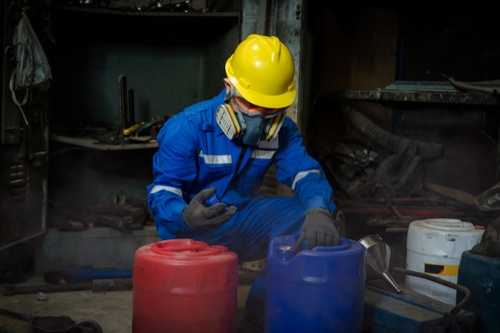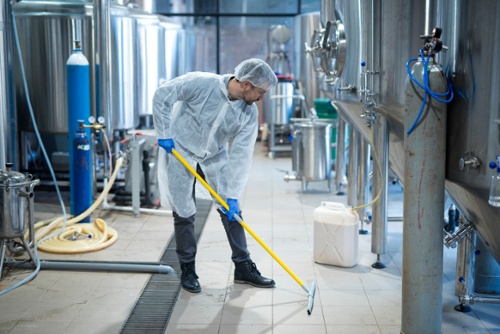Business owners and operators have an obligation to ensure that no-one at their workplace is harmed by chemicals or hazardous substances. This duty of care includes keeping airborne concentrations of hazardous chemicals within the legal limits, as stated in Safe Work Australia’s workplace exposure standards.
This post will help you understand the steps required when estimating chemical exposure levels in your workplace. We’ll also discuss workplace compliance with the workplace exposure standards for airborne contaminants, so you can protect workers from exposure to hazardous substances.
Estimating Levels of Chemical Exposure
To determine the chemical exposure standards of your substances, refer to Section 8: Exposure Controls/Personal Protection of the safety data sheet (SDS). This document will give you detailed information about the levels of exposure associated with each hazardous chemical at your site.
In addition to the exposure levels, it will also provide information on the appropriate personal protective equipment (PPE) that is required to avoid chemical exposure, including eye protection, skin protection and respiratory protection.

Controls to minimise the likelihood of exposure to hazardous substances may be found in your product's SDS in Section 8.
Considerations When Estimating Level of Exposure
If you’re carrying any type of hazardous substance in your workplace, it’s essential that you conduct a risk assessment. Your risk assessment will not only identify the physiochemical hazards associated with your products, it will also help you to understand the negative health effects that your chemicals could potentially cause to workers and others at risk of exposure.
When estimating the level of exposure to hazardous chemicals, consider:
- Possible routes of entry (petrol spilled onto the skin, ingested or inhaled vs diesel exhaust inhaled).
- Duration of exposure (1 hour per week for 10 years vs 8 hours per day for 1 month).
- How the chemical is being used (pouring a pesticide into a container vs spraying a pesticide on crops).
- Toxicity of the chemical (Schedule 7 Dangerous Poison vs Schedule 6 Poison).
- Quantity of the chemical (a worker pouring corrosive chemicals from a beaker into a test tube vs workers carrying out repairs to the lid covering a vat of corrosive chemicals).
- Concentration (cleaning with 5% ammonia mixed with water vs pure concentrate).
- Other chemicals being used (using an aerosol paint can in an isolated area vs using an aerosol spray can while operating an acetylene oxygen welder).
- Whether personnel are working directly with the chemicals (workers decanting chemicals into smaller containers vs maintenance crew carrying out repairs adjacent to the decanting station).
- Control measures already in place (PPE, exhaust fans, decanting stations, job rotation).
- Individual health factors (worker 30 years old non-smoker vs worker 55 years old who has asthma and smokes).
- Work history (new worker never exposed to chemicals vs worker who spent 10 years working with pesticides every day).
Health effects from exposure to hazardous chemicals can range from immediate reactions —such as allergic reactions, nausea and vomiting — to long-term health effects, including respiratory illnesses, cancer and even fatalities. These serious health hazards can be controlled, but only when the level of exposure is understood.
As you can see from the above list of considerations, the severity of a chemical health hazard is impacted by a multitude of factors — all of which must be considered in your risk assessment.
IMPORTANT: Need help with your onsite chemical risk assessment? Access our free downloadable template to get started.
Chemical Exposure Profile
We suggest collating all the data listed above and compiling a chemical exposure profile for your risk assessment.
To illustrate this process, we’ve created a scenario below that may occur in a range of workplaces. In this example, we’ve indicated the exposure profile of a single worker, but this could also be prepared for work teams or by department eg, warehouse employees exposed to diesel exhaust.

Workers may be exposed to chemicals when using, handling or storing these substances in the workplace.
Example 1: Worker X is using ammonia, a schedule 6 poison for cleaning. The ammonia is premixed to a concentration of 5% ammonia by a supervisor (so Worker X is never exposed to higher concentrations) and they clean for 3 hours per day (5 shifts per week). Worker X has been employed as a cleaner for 6 months and has never worked with chemicals before. He is a non-smoker and has no known allergies.
Cleaning is done in office buildings including toilets, cubicles, enclosed workspaces and meeting rooms. Most of the office buildings don’t have opening windows and the work is carried out in the morning before the air condition service is scheduled for operation. Worker X uses disposable latex gloves but no respiratory protection.
Chemical Exposure Testing Methods
Chemical exposure testing provides crucial information about the exposure to hazardous chemicals in the workplace. This testing allows organisations to determine the level of exposure and chemical hazards associated with the product, so they can ensure safety with their workforce.
IMPORTANT: Creating accurate chemical exposure profiles will help you identify workers who could be at risk of dangerous chemical exposure, as well as a priority list for exposure testing.
How to Test for Exposure
There are several ways you can test work areas for the presence of airborne chemicals including:
- Observation: simply looking for of evidence of airborne concentrations of chemicals. You might notice dust that has settled on people and equipment, mist or fumes visible in the air or against the light. The presence of chemical odours is also an indication.
- Simple tests: using commercially available dust lamps, indicator tubes and strip tests to give you a better idea of what chemicals may be present in work areas.
- Personal sampling: testing contaminants in the breathing zone of individual workers.
- Static sampling: testing air-borne contaminants in work zones to establish high risk operations and hazardous trends.
- Air monitoring: formal testing carried out by an occupational hygienist to ensure breathing zones are within workplace exposure levels and whether ventilation systems are operating correctly. In Australia air monitoring records must be kept for 30 years.
It’s important to remember that exposure levels may vary throughout a shift. These tests only indicate the presence of chemicals and cannot reliably measure concentration levels.
IMPORTANT: Professional chemical testing services may analyse air quality, as well as samples of blood and urine, or the testing of workplace surfaces or materials. Check with your local provider to see what testing they can provide for exposure to hazardous chemicals in the workplace.
Workplace Exposure Standards for Hazardous Chemicals
Hundreds of hazardous chemicals have a workplace exposure standard set by Safe Work Australia. If your workplace has any of these chemicals onsite, you must ensure that the air quality stays within the limits defined by the standards.
If you are using chemicals that are listed in the exposure standard, you will need to:
- Identify each chemical with a legal exposure limit
- Create an exposure profile for the workers using the hazardous substance or those at risk of being exposed to the chemical.
- Collate the exposure profiles and tag high risk profiles for exposure testing.
- Carry out preliminary observations and tests in those work areas to detect the presence of air-borne contaminants.
- Introduce suitable control measures (ventilation systems, work methods, rosters etc.).
- Carry out formal air monitoring to ensure air quality is within the exposure standards.
While chemicals can be absorbed through the skin, you may also have to carry out health monitoring or biological monitoring of workers to ensure they are not being harmed by the chemicals.
REMEMBER: Keeping chemical concentration levels within workplace exposure standards is not a standalone control measure or even an indication of a ‘safe breathing zone’. Chemicals affect people differently and the presence of other chemicals and even the climate can impact how a worker’s health may be harmed.
Exposure to Hazardous Substances
Learn how to include chemical exposure testing into your risk assessment by downloading our free eBook How to Manage The Risk of Hazardous Chemicals in the Workplace. We introduce a complete risk management plan, so you can effectively minimise chemical hazards and fulfil your WHS obligations. Access your free guide now and take the next step in controlling hazardous chemicals.
Joining the team as a Dangerous Goods Storage Consultant, Melissa Hampton became Storemasta's Marketing Manager in late 2021. With extensive knowledge and experience in chemical compliance, Melissa is responsible for leading the Marketing team and helping shape their marketing strategy. In her spare time, you can find Melissa hiking, swimming and enjoying the great outdoors in beautiful north-west Tasmania.
